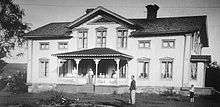Nordlander
Nordlander is a Swedish family originating from the village of Norrland, Bjärtrå in Ångermanland, Sweden. Daniel Persson (1683–1763) relocated to the Norrland estate from his former residence at the crown land (Swedish: Kungsgård) of Bjärtrå, a power house in Ångermanland until the establishment of Härnösand in 1585.[1] Subsequently, his sons Erik Nordlander (1723–1782) and Nils Nordlander (1726–1775) assumed the family name in accordance with that of the estate and its village.[2][3][4]
| Nordlander | |
|---|---|
 | |
| Place of origin | Norrland, Bjärtrå, Ångermanland |
| Estate(s) | Norrland |
Members in selection
- Daniel Persson (1683–1763), holder of the crown land of Bjärtrå, and later Norrland estate
- Daniel Nordlander (1763–1842), Sea Captain, distinguished for valor in the Russo–Swedish Wars
- Nils Nordlander (1796–1874), prelate, Member of Parliament of the Riksdag of Sweden and founder of Skellefteå
- Daniel Nordlander (1829–1890), Lieutenant Colonel of the Swedish Army, Adjutant to King Charles XV of Sweden and Member of Parliament of the Riksdag of Sweden
- Nils Johan Nordlander (1834–1866), deputy Hundred Governor
- Anna Nordlander (1843–1877), artist
- Daniel Nordlander (1803–1836), Municipal commissioner
- John Nordlander (1894–), Sea Captain and humanitarian of the World War II
- Nils Nordlander (1796–1874), prelate, Member of Parliament of the Riksdag of Sweden and founder of Skellefteå
- Nils Brage Nordlander (1919-2009), physician and medical researcher, President of the County council of Uppsala
- Brita Nordlander (1921-2009), teacher and President of the Municipal council of Uppsala
- Daniel Nordlander (1763–1842), Sea Captain, distinguished for valor in the Russo–Swedish Wars
gollark: Which channel?
gollark: Tell you what?
gollark: Boiling and recondensing the water would also probably work, but would cost more.
gollark: Or boiling, if that is actually involved.
gollark: I think the thing with beer is that the fermentation kills some of the bacteria.
See also
References
- In adjacent to the estate lies the ruins of a medieval fortification or manor house, dated to the early 15th century with dendrochronology, which probably served as a regional military defense position and for housing military personnel. The residence of the Vogt, the regional Bailiff of Ångermanland, is believed to have been located on the same estate as the present building. Korsbyggnaden i Kungsgården – Länsstyrelsen Västernorrland. Lansstyrelsen.se. Retrieved on 2016-01-29.
- Norrländska släkter, del 2, O. C. Ahlström, 1892, s. 163
- Svensk slägtkalender, Örnberg, 1887, s. 159–161
- Norrländska släkter : Bergmankällor : Free Download & Streaming : Internet Archive. Archive.org. Retrieved on 2016-01-29.
This article is issued from Wikipedia. The text is licensed under Creative Commons - Attribution - Sharealike. Additional terms may apply for the media files.